|
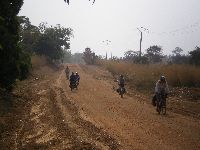
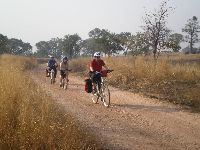 In
Kande we departed the relative luxury of the national highway and continued on a firm dirt and gravel road. The
morning temperature were cool and savannah-like countryside is flat so
travel was slower than on the pavement but very pleasant. Little
whiffs of smoke were coming from some of the homesteads, adults who
must have left their home at first light were
working on their farms and children were emerging from the gates of their
houses,
carrying their book bags for the trip to school. In
Kande we departed the relative luxury of the national highway and continued on a firm dirt and gravel road. The
morning temperature were cool and savannah-like countryside is flat so
travel was slower than on the pavement but very pleasant. Little
whiffs of smoke were coming from some of the homesteads, adults who
must have left their home at first light were
working on their farms and children were emerging from the gates of their
houses,
carrying their book bags for the trip to school.
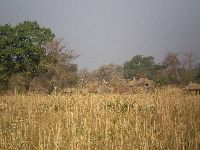
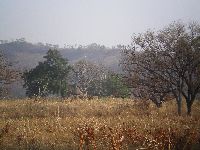
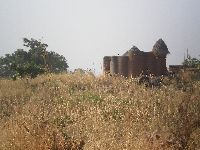
While the whole valley has a beauty to it, the ultimate
reason for making the extra effort to follow this road is to see the unique
residential architecture.
Between Kande, Togo, and
Bamouké, Benin, is the Koutammakou World Heritage area. Koutammakou is
the name of the landscape. One of several names for the ethnic group
in the area is Batammariba (a.k.a. Somba, Tammari
and Tembera
people.)
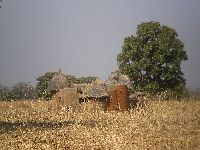
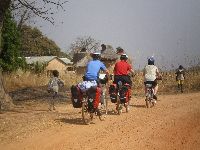
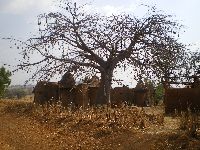
The area is known for it multi-storey, towering takienta
houses, often tuck in among clumps of trees. (The house are also referred to a tata somba, which translates as
"house somba".) Animals are sheltered on the ground floor at night
and in bad weather cooking is done in alcoves on the ground floor. People tend to live on the
first story and roof -- sleeping outside in the hot season and in round
chambers when it is cooler. Granaries
and agricultural product storage silos are constructed into the walls of the
building or on the roof. The building's high, shear, exterior walls act well as
defensive structure. This was enhanced because traditionally the house
were
often located up on the side of hills and in the crags of cliffs. One
of the explanations for the evolution to this style of architecture was as a defense
against raids (sometimes for slaves) by the Dahomey King, from the south
(see "Dispatch 8").
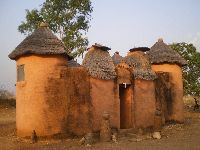 Their buildings' esthetic is enhanced because their
appearance changes as the lighting from the sun shifts throughout the day.
With so many round and irregular surfaces, varying heights, adobe walls and multiple
textures, shadows shift around, colors change and light falls in new ways. Their buildings' esthetic is enhanced because their
appearance changes as the lighting from the sun shifts throughout the day.
With so many round and irregular surfaces, varying heights, adobe walls and multiple
textures, shadows shift around, colors change and light falls in new ways.
 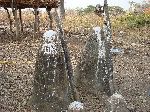 Near the entrances to houses there are often pairs of
altars, reflecting the traditional animist religion of the Tembera people.
These are similar to the Voodoo altars and ancestral figures seen closer to the coast,
but the Tembera figures tend to be more cylindrical and less
anthropomorphic. Near the entrances to houses there are often pairs of
altars, reflecting the traditional animist religion of the Tembera people.
These are similar to the Voodoo altars and ancestral figures seen closer to the coast,
but the Tembera figures tend to be more cylindrical and less
anthropomorphic.
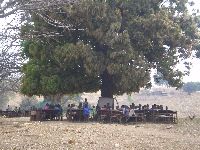
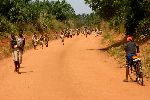 While the cultural context and architecture are striking,
the local residents seem to be increasingly more focused on commercialism
than culture. The World Heritage designation and increase exposure
that has come from it has had the benefit of reviving interest in the traditional
architecture of the region. There are now many more towering houses
than there have been for at least three decades -- many of the new
structures having been sighted very accessibly, adjacent to the road.
One of the criticism of the World Heritage certification program is it can
have the affect of freezing a culture or cultural element. In this
situation it may have frozen one part of the culture while stimulating
another part to become
commercialized faster than it would otherwise have evolved. While the cultural context and architecture are striking,
the local residents seem to be increasingly more focused on commercialism
than culture. The World Heritage designation and increase exposure
that has come from it has had the benefit of reviving interest in the traditional
architecture of the region. There are now many more towering houses
than there have been for at least three decades -- many of the new
structures having been sighted very accessibly, adjacent to the road.
One of the criticism of the World Heritage certification program is it can
have the affect of freezing a culture or cultural element. In this
situation it may have frozen one part of the culture while stimulating
another part to become
commercialized faster than it would otherwise have evolved.
The physical location also creates a limitation for non-acclimatized
visitor: Mostly set in a valley, the sun broils the land to a point that by
noon, and for several hours after that, it is too hot for non-natives to be active in the
open for more that a few minutes. The lesson for visitors is to finish the
excursions in the morning and bring a lot of water.
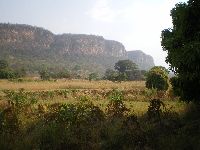 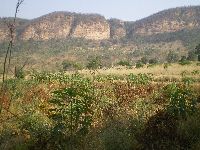 To
the east of Koutammakou is the Benin extension of the range of mountains
that crosses Togo near Bafilo. It takes a considerable effort to get to the top by
bicycle -- chances are you will walk part of it -- but the To
the east of Koutammakou is the Benin extension of the range of mountains
that crosses Togo near Bafilo. It takes a considerable effort to get to the top by
bicycle -- chances are you will walk part of it -- but the
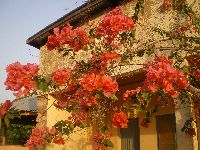 views
and change (though maybe only slight or imaginary) in views
and change (though maybe only slight or imaginary) in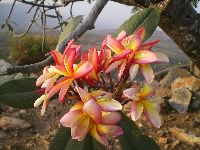 climate at the top are sufficient rewards.
Most conveniently,
a local entrepreneur has built a delightful, small auberge at this strategic
spot and placed a gazebo at the edge of the mountain perfect for relax with a magnificent
sweeping view at your feet. Have a drink, take a meal and sleep almost in
paradise -- or so it seems after scaling the mountain.. climate at the top are sufficient rewards.
Most conveniently,
a local entrepreneur has built a delightful, small auberge at this strategic
spot and placed a gazebo at the edge of the mountain perfect for relax with a magnificent
sweeping view at your feet. Have a drink, take a meal and sleep almost in
paradise -- or so it seems after scaling the mountain..
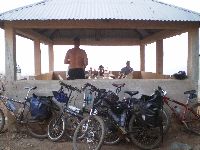
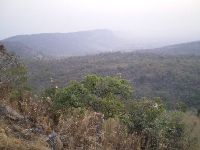
|


















